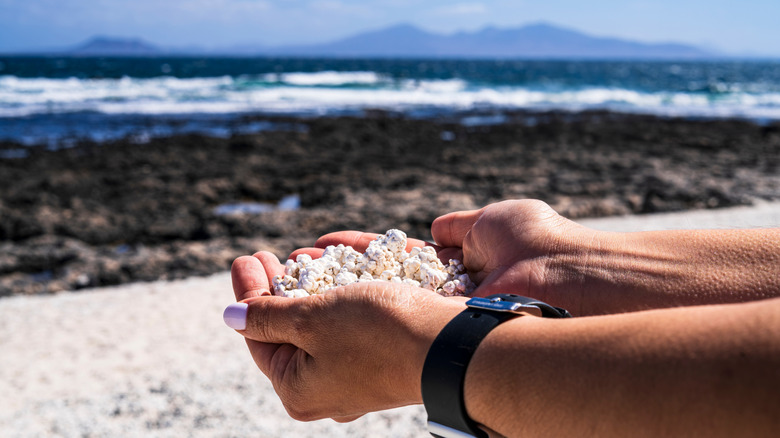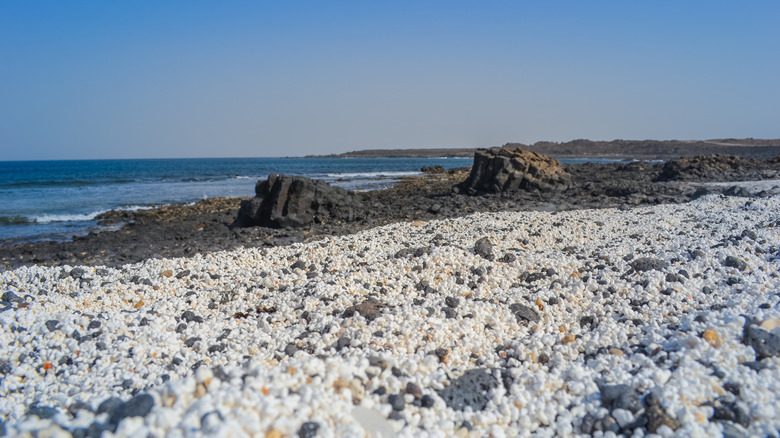This European Beach Went Viral For Its Popcorn-Like Sand (And It's Not Just A Pretty Sight)
When searching for scenic shorelines, photographers often get hung up on hue. And while there is an array of colorful beaches around the world you should visit at least once in your lifetime, you can find a wide variety of textured beaches, too. There are pebble beaches, sand glass beaches, volcanic sand beaches ... and on the rugged paradise of Spain's oldest Canary Island, Fuerteventura, there's even a beach with sand that looks so tasty you might be tempted to try a nibble.
The internet has recently gone wild for Fuerteventura's northern shores — they're covered with kernels of what looks like fluffy white popcorn puffs. Both Playa de El Hierro (also known as "Iron Beach") and Playa del Bajo de la Burra (or "beach of the donkey's underbelly") are covered in this snack for the eyes and have both become widely known in English by the name of Popcorn Beach. The "popcorn," as explained by Canary Islands Tourism, are hard, porous formations called rhodoliths (or maërl) washed ashore: "Rather than heated maize, the swollen material is in fact white coral which has been made as a consequence of the intermixture of calcareous algae and white sand over a period of at least 50 years."
According to the science, it takes at least 25 years for an inch-long piece of "popcorn" sand to grow underwater before washing ashore. Some of the kernels on El Hierro and Bajo de la Burra are at least 4,000 years old! While it's perfectly fine to lounge about and snap photos of yourself pretending to eat a handful, rhodoliths should not be eaten, damaged, or removed from the beach. During their life cycle, these precious corals act like plants and absorb carbon dioxide from the air and sea, an important factor in fighting climate change.
How to safely enjoy Popcorn Beach, according to experts
Any of Fuerteventura's Popcorn Beaches is an impressive sight to see: imagine perfect turquoise water and foaming surf crashing onto a sprawl of black volcanic rock and enough popcorn to fill a cineplex. Plus, these beaches aren't just for far-flung adventure seekers or influencers willing to go to the ends of the Earth for the perfect pic. In fact, Playa del Bajo de la Burra's proximity to the popular resort town of Corralejo makes it an easy outing for casual tourists — you can bike there in 20 minutes or even make your way on foot if you're in the mood for a sunny coastal walk.
However, with more sparkling clean Blue Flag beaches than any country in the world, Spain is serious about protecting its beaches. Marine biologists and environmental activists caution visitors to be careful when coming to see this unique popcorn coral. In addition to purifying the air, the rhodoliths provide breeding grounds for egg-laying creatures. Therefore, it's essential that visitors remember to leave the beaches exactly as they found them, and not treat this ecologically invaluable sand as a souvenir. Otherwise, the shorelines might soon disappear — it's been estimated that, for the last few years, tourists have been siphoning away as much as 22 pounds of popcorn per month!
Today, visitors can be fined anywhere upwards of $3,000 if they remove sand from Popcorn Beach. They should avoid swimming, not only to protect the coral but because the water crashing onto the shore's volcanic rock can make the surf far too rough. Instead, a picnic pairs perfectly with a pic of your popcorn "snack." When you're done, continue strolling along Fuerteventura's northern headlands within La Caleta nature preserve or head south to witness the impressive Corralejo Sand Dunes.

